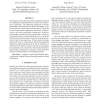Free Online Productivity Tools
i2Speak
i2Symbol
i2OCR
iTex2Img
iWeb2Print
iWeb2Shot
i2Type
iPdf2Split
iPdf2Merge
i2Bopomofo
i2Arabic
i2Style
i2Image
i2PDF
iLatex2Rtf
Sci2ools
ICASSP
2010
IEEE
2010
IEEE
Classifying laughter and speech using audio-visual feature prediction
In this study, a system that discriminates laughter from speech by modelling the relationship between audio and visual features is presented. The underlying assumption is that this relationship is different between speech and laughter. Neural networks are trained which learn the audio-to-visual and visual-to-audio features mapping for both classes. Classification of a new frame is performed via prediction. All the networks produce a prediction of the expected audio / visual features and the network with the best prediction, i.e., the model which best describes the audiovisual feature relationship, provides its label to the input frame. When trained on a simple dataset and tested on a hard dataset, the proposed approach outperforms audiovisual feature-level fusion, resulting in a 10.9% and 6.4% absolute increase in the F1 rate for laughter and classification rate, respectively. This indicates that classification based on prediction can produce a good model even when the available da...
| Added | 06 Dec 2010 |
| Updated | 06 Dec 2010 |
| Type | Conference |
| Year | 2010 |
| Where | ICASSP |
| Authors | Stavros Petridis, Ali Asghar, Maja Pantic |
Comments (0)

